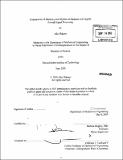Comparisons of harmony and rhythm of Japanese and English through signal processing
Author(s)
Nakano, Aiko
DownloadFull printable version (5.194Mb)
Other Contributors
Massachusetts Institute of Technology. Dept. of Mechanical Engineering.
Advisor
Barbara Hughey.
Terms of use
Metadata
Show full item recordAbstract
Japanese and English speech structures are different in terms of harmony, rhythm, and frequency of sound. Voice samples of 5 native speakers of English and Japanese were collected and analyzed through fast Fourier transform, autocorrelation, and statistical analysis. The harmony of language refers to the spatial frequency content of speech and is analyzed through two different measures, Harmonics-to-Noise-Ratio (HNR) developed by Boersma (1993) and a new parameter "harmonicity" which evaluates the consistency of the frequency content of a speech sample. Higher HNR values and lower harmonicity values mean that the speech is more harmonious. The HNR values are 9.6+0.6Hz and 8.9±0.4Hz and harmonicities are 27±13Hz and 41+26Hz, for Japanese and English, respectively; therefore, both parameters show that Japanese speech is more harmonious than English. A profound conclusion can be drawn from the harmonicity analysis that Japanese is a pitch-type language in which the exact pitch or tone of the voice is a critical parameter of speech, whereas in English the exact pitch is less important. The rhythm of the language is measured by "rhythmicity", which relates to the periodic structure of speech in time and identifies the overall periodicity in continuous speech. Lower rhythmicity values indicate that the speech for one language is more rhythmic than another. The rhythmicities are 0.84±0.02 and 1.35±0.02 for Japanese and English respectively, indicating that Japanese is more rhythmic than English. An additional parameter, the 80th percentile frequency, was also determined from the data to be 1407±242 and 2021±642Hz for the two languages. They are comparable to the known values from previous research.
Description
Thesis (S.B.)--Massachusetts Institute of Technology, Dept. of Mechanical Engineering, 2009. Cataloged from PDF version of thesis. Includes bibliographical references (p. 24-25).
Date issued
2009Department
Massachusetts Institute of Technology. Department of Mechanical EngineeringPublisher
Massachusetts Institute of Technology
Keywords
Mechanical Engineering.